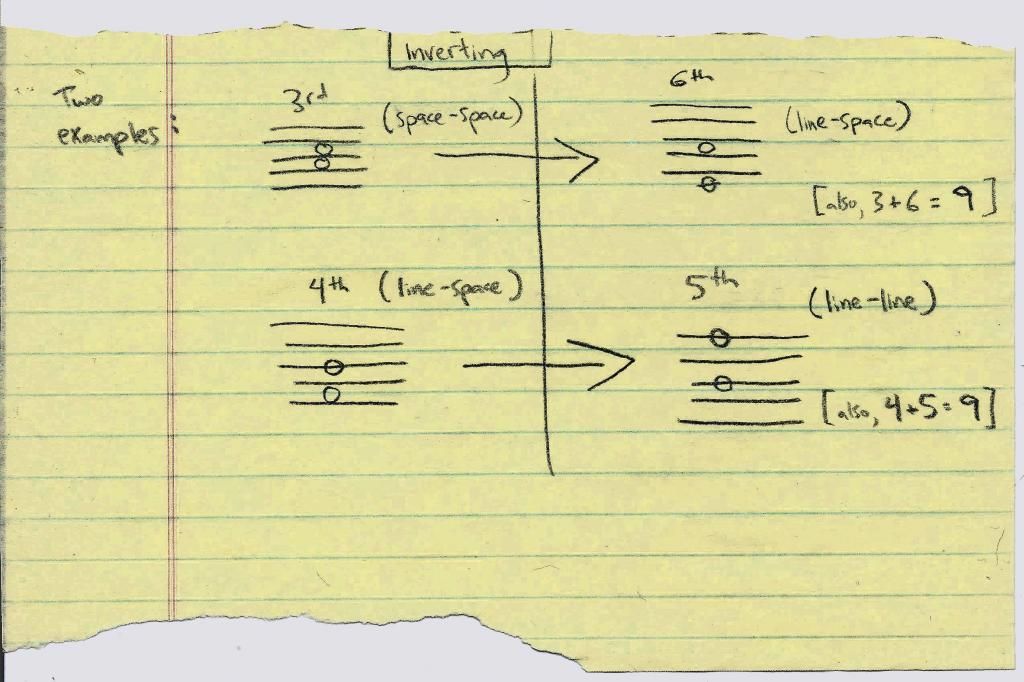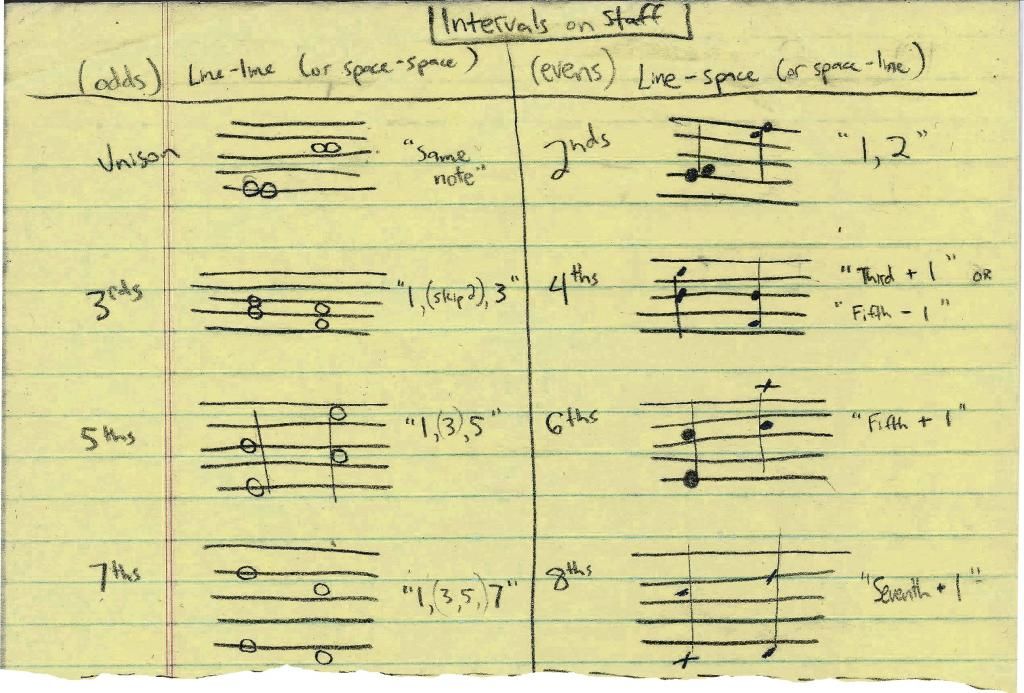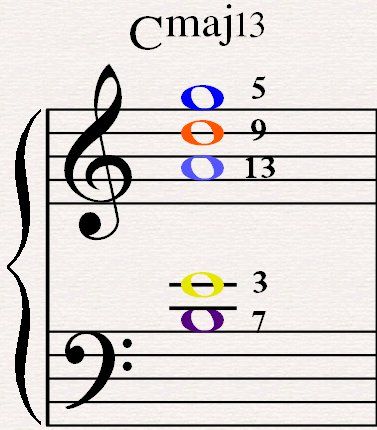The "Drop 2" chord voicing technique is a common arranging/composing/piano trick. It's a great way to voice a chord for a horn section, or if you're a piano player, it's a slick way of creating strong 4- or 5-note voicings.
It's simple:
1) Start with a 4-note chord that exists all within an octave. (This may be a chord in root position, but may also be a different inversion of a chord, or some other type of cluster.)
2) Identify the second highest note (the "2" of "Drop 2").
3) Move this note down an octave.
That's it!
Here's a step-by-step video showing the process:
Tuesday, August 26, 2014
A Handful of Major Chord Voicings (with colorful illustrations) [Part 2 of 2]
In Part 1 of this series, the handful of major chord voicings was introduced along with an accompanying A/V example.
Now, in Part 2, each voicing will be colorfully broken down.
I will show each voicing notated on a grand staff, using a color-coded system. In the system, each scale degree (in these case of C major) is assigned a color, following the order of ROYGBIV. Since there are 7 notes in a scale, and 7 distinct colors in the visible light spectrum, this works out nicely. (This colorful choice of mine was inspired by this very interesting article about the link between Music and Color.)
*Please note that the people I attribute the following voicings to (and therefore the labels I assign each one), are by no means the originators of a particular voicing. Rather, they are the musicians/educators from whom I personally learned each voicing. (I will link to the relevant sources as we go along.)
1) Symmetrical "Martin" Cmaj13 (via Peter Martin)
2) "Tristano" Cmaj6/9 (a la Lennie Tristano)
3) Rootless "A Position" Quartal Voicing, Cmaj6/9 (via Earl MacDonald)
4) "B Position" Quartal Voicing, Cmaj13 (via Earl Macdonald)
5) "Drop 2" Cmaj9
Now, in Part 2, each voicing will be colorfully broken down.
Color-Coding Chord Tones
 |
| C major scale, in colors. |
*Please note that the people I attribute the following voicings to (and therefore the labels I assign each one), are by no means the originators of a particular voicing. Rather, they are the musicians/educators from whom I personally learned each voicing. (I will link to the relevant sources as we go along.)
Five Colorful Voicings
- Symmetry in intervals: 3rd, 4th, 4th, 4th, 3rd
- Very similar to the next voicing (Tristano), but more colorful because it contains the 7th
- LH contains a minor chord in first inversion, RH contains a major chord in second inversion

2) "Tristano" Cmaj6/9 (a la Lennie Tristano)
- Top four notes are spaced out by a 4th
- Root is doubled, appearing on the very bottom and top of the voicing
- Tristano often used this by "planing" this shape, moving it up or down chromatically
3) Rootless "A Position" Quartal Voicing, Cmaj6/9 (via Earl MacDonald)
- 3rd on bottom (root on top)
- Basically the same as Tristano's voicing, but without the root doubled in the LH
4) "B Position" Quartal Voicing, Cmaj13 (via Earl Macdonald)
- 7th on bottom (5th on top)
- Rootless
5) "Drop 2" Cmaj9
- Notes are not as evenly-spaced in this one (not as quartal as the others)
- The B (the 7th) was lowered by an octave
- To learn how to construct any voicing using the Drop 2 technique, click here.
Final Remarks
What to do with all of this information? If you happen to latch on to the sound/feel of one or two of these, take a second to figure it out on the piano. Divide the notes between hands however is most comfortable to you (in some 5-note cases, it may be preferable to put three notes in the LH, two in the RH, but you might prefer it the other way around). From there, continue around the Cycle of Fourths (or Fifths), constructing the voicing slowly and carefully.
Happy voicing!
A Handful of Major Chord Voicings (with colorful illustrations) [Part 1 of 2]
Prepare yourself to play some of these pretty chords. In general, they more-or-less all share the following characteristics:
- Mostly quartal (stacked in fourths)
- Contain extensions such as the 6th (13th) or 9th
- Relatively equal spacing between notes
- Sound really great
Here they are all together on one line of music, with an accompanying video (listen for the subtle differences between each voicing):
 |
| (These labels I assigned each one will be explained in Part 2.) |
In the next installment [Part 2 of 2], I will show you how to construct each of these voicings.
Thursday, August 14, 2014
Inverting Intervals
To invert an interval means to move one note (out of the two) up or down by an octave. For example, to invert a 3rd (C and the E above), I can move the C up an octave. This effectively puts the C above the E. So, the new order from lower to higher is E up to C. Furthermore, this creates a different interval: the 3rd became a 6th.
Here's a visual, which matches the style of a previous post on reading intervals from a staff:
 |
| When you invert an interval on the staff, its line/space category becomes reversed (same to different, or different to same). Click to enlarge. |
You'll see that interval numbers of each inversion pair always add up to 9:
- A unison inverts to an octave (1+8=9)
- A 2nd inverts to a 7th (2+7=9)
- A 3rd inverts to a 6th (3+6=9)
- A 4th inverts to a 5th (4+5=9)
- And vice versa
Seeing Intervals on a Staff
When I teach beginner-level piano students, one of the first things they learn is the "step" vs. "skip" concept. This coincides with their introduction to reading music from a staff. If a "line" note goes up to the adjacent "space" note, we call it a step (like stepping up on a flight of stairs). But if that line note goes up to a note on the next line above, we call it a skip (it is skipping the space between the lines). This is often how students begin their understanding of intervals. They soon learn that the line-space example is called a 2nd, and the line-line example is a 3rd.
Beyond 2nds and 3rds, of course, the intervals become larger, and perhaps can be a little trickier to identify on a staff. Fortunately, with a little practice, this becomes easier and easier, until soon enough it is second-nature.
Here's a handwritten sheet showing what different intervals (unisons up to octaves) look like on the staff (5 lines, 4 spaces) The ability to quickly recognize an interval (and eventually, several intervals/chords at once) when reading from written music notation--especially when sight-reading--is very valuable.
In quotation marks, I wrote out simple mental steps someone might go through when looking at each interval. Visually, when I see a 7th, I like to imagine climbing up the rungs of a ladder (i.e. going from one line to the line above). On each rung, I can count up by odd numbers: "1, 3, 5, 7." A four-line ladder means I'm looking at a 7th.
The basic nugget of information to take-away from this post is this:
Intervals of Odd Numbers (1, 3, 5, 7) always appear as line-line or space-space.
Intervals of Even Numbers (2, 4, 6, 8) always appear as line-space or space-line.
To help visualize these intervals in another way (pianists especially), it would be a good idea to plunk out each of the intervals depicted above on a keyboard. Begin doing this in the key of C major (all white keys), and when comfortable try out some other keys in order to incorporate black keys into your visual memory bank.
Beyond 2nds and 3rds, of course, the intervals become larger, and perhaps can be a little trickier to identify on a staff. Fortunately, with a little practice, this becomes easier and easier, until soon enough it is second-nature.
Here's a handwritten sheet showing what different intervals (unisons up to octaves) look like on the staff (5 lines, 4 spaces) The ability to quickly recognize an interval (and eventually, several intervals/chords at once) when reading from written music notation--especially when sight-reading--is very valuable.
 |
| I hope my handwriting is legible for you. Click to enlarge. |
The basic nugget of information to take-away from this post is this:
Intervals of Odd Numbers (1, 3, 5, 7) always appear as line-line or space-space.
Intervals of Even Numbers (2, 4, 6, 8) always appear as line-space or space-line.
To help visualize these intervals in another way (pianists especially), it would be a good idea to plunk out each of the intervals depicted above on a keyboard. Begin doing this in the key of C major (all white keys), and when comfortable try out some other keys in order to incorporate black keys into your visual memory bank.
Subscribe to:
Posts (Atom)




